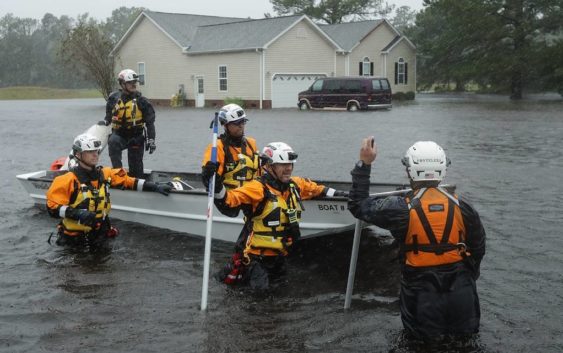- Seven months after Hurricane Helene, Chimney Rock rebuilds with resilience
- Wildfire in New Jersey Pine Barrens expected to grow before it’s contained, officials say
- Storm damage forces recovery efforts in Lancaster, Chester counties
- Evacuation orders lifted as fast-moving New Jersey wildfire burns
- Heartbreak for NC resident as wildfire reduces lifetime home to ashes
At least 5 dead, 640,000 without power as Florence’s toll mounts on Carolinas

With one grueling day behind them, the Carolinas on Friday grappled with rising water and cascading misery from a deadly and agonizingly slow-moving Tropical Storm Florence expected to linger through the weekend.
In Myrtle Beach, rescuers discovered a dead mother and her baby, two of at least five deaths blamed on the storm, after spending much of the day trying to cut through debris and a towering tree that crashed through their roof. The Cajun Navy, a rescue team formed after Katrina, scoured the small town of New Bern for victims when overnight flooding sent residents to their attics and rooftops.
The massive system weakened into a tropical storm in the late afternoon but across the region, emergency officials warned that more water was yet to come, with cresting rivers and flash flooding fed by the unending rain.
The Cape Fear river crested at 8.27 feet about 3:30 p.m., setting a new record and by Wednesday, the Maccamaw River may climb to 17.1 feet, the National Weather Service’s Wilmington office reported, just shy of its record.
When all is said and done, Florence could dump 18 trillion gallons along its path, according to meteorologist Ryan Maue. Parts of North Carolina could see enough torrential rain to qualify as a thousand-year flood, said North Carolina Gov. Roy Cooper. As all that run-off fills rivers, the damage will only worsen.
“Remember that rivers will keep rising for days even after the rain stops,” he warned. “The storm is wreaking havoc on our state.”
Atlantic Beach’s historic pier was washed away. To the south, storm surge pushed water levels at Johnny Mercer Pier at Wrightsville Beach, where Florence made landfall at 7:15 a.m. with 90 mph winds, to more than 8.5 feet. Tomorrow, forecasters expect it to climb over nine feet.
By Friday evening, nearly 640,000 people in North Carolina alone were without power.
In New Bern, the picturesque riverfront town and birth place of Pepsi, where the Neuse and Trent rivers meet, incoming Mayor Sabrina Bengel said hundreds had been rescued after residents began calling before daybreak as waters rose to rooftops. About 4,300 homes were damaged, she said, affecting a third of the small town’s population.
“We’ve had people in attics, on top of roofs,” she said. “It’s been occurring all night.”
Hurricane Florence began lashing the coast Thursday morning, sending pounding waves ashore and rising storm surge. As the storm stalled, forecasters warned ”torrential rains will come:” an additional 20 to 25 inches in eastern North Carolina and up to 15 inches inland. By 3 p.m., more than 15.5 inches had accumulated in Moorehead City, the National Hurricane Center reported. Through the day, the storm’s pace slowed even more, from 10 mph Thursday morning to 3 mph by Friday evening.
“The slower it moves, the longer these rain bands take,” National Hurricane Center Ken Graham warned.
During the day a faulty rain gauge briefly caused inaccurate rain estimates — some as high as 30 inches — which the National Weather Service quickly corrected. The U.S. Geological Survey maintains the gauges, which during storm can get battered and cause faulty readings.
“In Harvey, vibration from wind caused [one] to register rain,” said hydrodynamics branch chief Robert Holmes. ”If the number seems really crazy high, you always have to have some suspicion until we can actually get out and verify it.”
While many sought shelter — about 26,000 people took refuge in 100 shelters and at the 14,000-seat Joel Colisseum in Winston-Salem — others ignored warnings or headed to nearby hotels. More than 1.7 million were ordered to evacuate in advance of the storm.
At the Comfort Suites in Wilmington, hotel staff hiding out with news crews and storm refugees were left in the dark when the power went out. Before daybreak, resident Mitchell Foor arrived with a generator, cranking up the hotels ice and coffee machines.
“I firmly believe in Karma,” said Foor, who helped rescue 100 victims after Hurricane Matthew in 2016.
About 70 people were pulled from a motel near Camp LeJeune at the height of the storm as the roof started to collapse. Water rescues were also underway, although it was hard to know how many had occurred. New York emergency workers reported rescuing elderly residents at a New River retirement community. Craven County officials said they responded to 200 calls for help.
In the coming days, Florence’s path and pace may cause it to send storm bands back over areas already hammered by heavy rain — what’s known as training — dumping even more water and making conditions even more hazardous for both residents and rescuers. As the storm moves into hilly terrain, it’s also expected to unleash catastrophic and potentially deadly flash flooding and possibly mud slides, the hurricane center warned.
This story was compiled from McClatchy papers in North Carolina, the Charlotte Observer and Raleigh News & Observer; and in South Carolina, The State in Columbia, the Beaufort Gazette,The Island Packet in Hilton Head and The Sun News in Myrtle Beach; and supplemented with wire service reports.
Follow Jenny Staletovich on Twitter @jenstaletovich